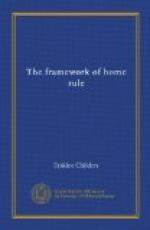The crisis in Lower Canada was precipitated, and, indeed, provoked, by a challenge thrown out in March, 1837, from the British House of Commons, where, at Lord John Russell’s instance, the Ten Resolutions were agreed to, which amounted in effect to a denial of all the colonial claims and a declaration of war upon those who made them. Papineau had to eat his words or make them good, and he chose the latter course. His insurrection was arranged in concert with that of the Upper Province, broke out simultaneously in the winter of 1837, and was extinguished with little difficulty. The men who made it suffered. Canada and the Empire profited. Both Papineau and Mackenzie, following the precedent of Wolfe Tone with France, endeavoured with little success to engage American sympathy and the aid of her army, though Canada had as little desire for American rule as Ireland had for French rule.
Let us remark, as an interesting fact for those who imagine that Irishmen are always instinctively on the side of turbulence and disorder, that the Irish immigrants who poured into Canada at the average annual rate of 20,000 in the years—terrible years in Ireland—preceding the rebellions,[23] acted much as we might expect. In the Lower Province, following the lead of the French Catholic hierarchy, they declared in November, 1837, against Papineau’s party, and thus strengthened the hands of the Government when the crisis approached.[24] In the Upper Province Catholics were strongly on the side of reform, but took no part in the rebellion. Orangemen in both Provinces, as we might guess, sided as strongly with the ascendancy parties, but colonial air seems to have taken some of the theological venom out of Orangeism. If Charles Buller is to be trusted, some Catholics joined the societies in Upper Canada, which were more Tory than religious, and the healths of William of Orange and the Catholic Bishop Macdonnell were drunk in impartial amity.[25]
In the meantime, three of the four outlying Provinces of North America—Nova Scotia, New Brunswick, and Prince Edward Island—where the same form of Constitution prevailed as in Upper and Lower Canada, had been passing through a similar phase of misgovernment and agitation during the previous thirty years. Each suffered under a little monopolist ascendancy, called by the same name, “the family compact,” and sustained, against the prevailing sentiment and interest, by the British Governor, and in each had arisen, or was arising, the same loud demand for responsible government. Samuel Wilmot in New Brunswick, Joseph Howe in Nova Scotia, were the best-known spokesmen. There was no violence, but a growing dislocation. In five Provinces of North America, therefore, the Colonial Government had broken down or was tottering, and from exactly the same cause as in Ireland, though under provocation infinitely less grave. For the moment, however, attention was concentrated upon the Canadas, where, as a result of the rebellion, the Constitution of Lower Canada was suspended early in 1838. In the summer of 1838 Lord Durham, the Radical peer, was sent out by Melbourne’s Ministry as Governor-General, with provisionally despotic powers, and with instructions to advise upon a new form of government.




